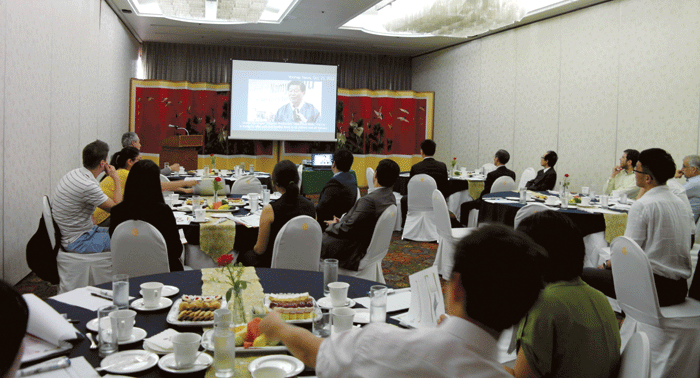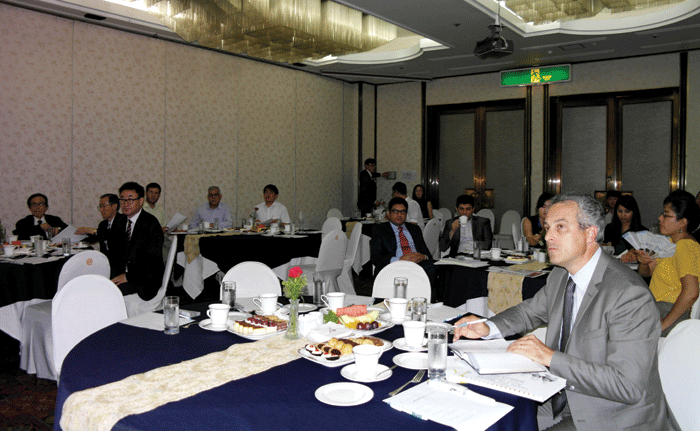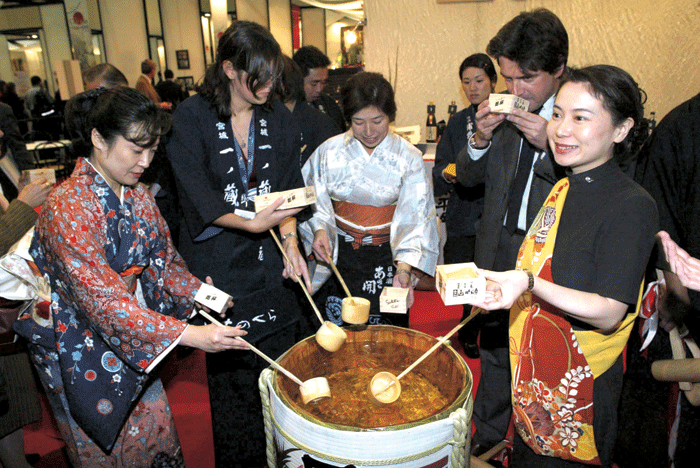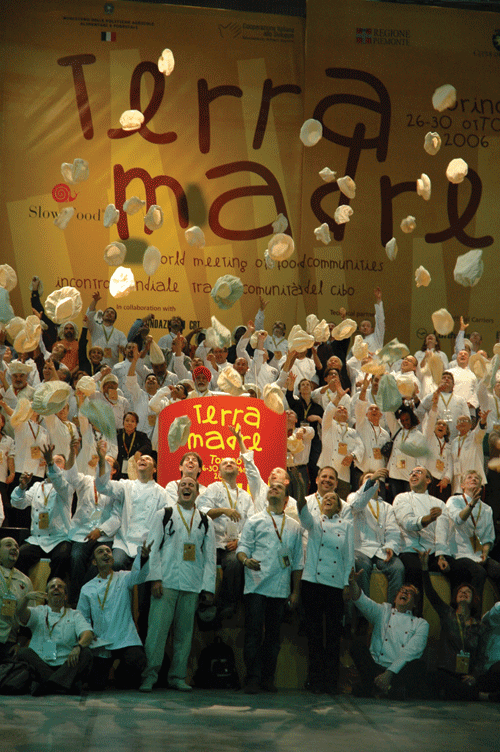LOCAL AUTONOMY
First Briefing Session on participation in Slow Food Expo
AsiO Gusto offers flexibility
for maximum participation
The first Briefing Session of the 2013 Namyangju International Slow Food Expo for Asia and Oceania (AsiO Gusto) was held over coffee and refreshments at the Deoksu Hall of the Capital Hotel in Yongsan, Seoul on the afternoon of August 16, 2013.
Various videos were shown introducing details of the Slow Food Expo for Asian and Oceania, which explained in detail various aspects of the Expo.
Then there was introduction of the details of the Expo by General Manager Ms. Park of the Organizing Committee and a question-answer session.

Highlights of the discussions:
1. There are two different venues. One is the International Hall and the other is the Street Food Festival Site.
2. International Hall:
The International Hall will have booths of 27 Asian-Oceanian countries. The countries are: Indonesia, Japan, the Philippines, Georgia, Nepal, Laos, Malaysia, Bangladesh, Sri Lanka, Afghanistan, Uzbekistan, India, China, Kyrgyzstan, Taiwan, Tasjiistan, Thailand, Pakistan, Vietnam, Kazakhstan, Monglia, Tibet, Iran, Israel, New Zealand, Austrailia and New Caledonia.
Each of the two volunteers of the above countries recommended by the Embassies will be paid 70,000 won per day by the Organizing Committee. They will be asked to wear their national costumes.

3. World Street Food Venue:
The World Street Venue will have booths for a total of 20 to 40 countries of the world. who are not included in the list of the Asian-Oceanian countries. However, it is open also to the the Asian-Oceanian nations of they wish to take part.
4. 10,000 visitors are expected on each of the Opening day, Rock Festival Day and the Citizens' Day.

Excerpts from questions and answers follow:
Room and board accommodation of participants: The host provides free room and board for the participants from overseas.
Free bus transportation:
There is free bus service for the participants. The bus will stop at some points in Seoul where they can board and leave the bus.
Ready-made foods:
Ready-made foods can be displayed and sold as well as those cooked on the spot at the venue. The participants can bring and sell pre-cooked food such as cookies, cakes, candies, buns, bread and/or any other ready-made foods. The Slow Food Expo takes place on October 1 to 6, 2013 when the temperatures are just nice and good for maintaining the freshness of the foods. The ready-made foods can also include dried fruits, nuts and salted and fermented foodstuff. Many Koreans like exotic food and beverage and such ready-made foods of the different countries would become popular.
Price of foods and handicrafts:
The price of foods and handicrafts can be determined by the participants. However, simple foods and small handicrafts items are most popular among the common people when the price ranges between 1,000 won and 5,000 won. The prices can be set by the sellers depending on the different items.
Are there limits to the quantity?
There are no limits to the quantity of foods, handicrafts and other items brought to the venue for display, sampling and sale. However, if the quantity is excessively large to the extent where other countries cannot be accommodated due to limited space, the host can ask for adjustment of the quantity of foods and goods.
Is there a fireplace for barbecue-cooking at International Hall?
Barbecue-cooking on charcoal fire would be difficult inside the International Hall.
However, it will be possible at the Booth Kitchens at the Street Food Festival.
Should participants stay for all six days?
No. the principal person does not have to stay for all six days. However, he/she should leave some persons to take care of the booth during his/her absence. The Organizing Committee can provide volunteers if they are desired for continued promotion of the country.
Can alcoholic beverage be brought in and sold?
Of course, yes. The Slow Food Expo is a place where all the different countries can boost their representative slow foods, beverage and handicrafts. The beverage can be sold in range of this spirit.
What is the procedure for application for participation?
We are now accepting applications for participation through email. In due course, the Organizing Committee will send an application form to each prospective applicant by email.
Koreans are excited about foreign goods:
Koreans, especially young people, like uncommon things such as ornamental accessories from other countries. Traditional costumes from different countries will be of strong interest to them. Just look around yourself and I am sure that there are things you may find to be so common that they are tired of looking at them. Why don't you trade them for Korean goods? Sell the handicrafts of your country at your booth and buy Korean things at the Korean market?

Good opportunity for promoting your country:
This is a great opportunity forboost the nice things about your country to the Korean and international audience. The International Slow Food Expo is a prestigious international culinary and cultural event and I hope that the participants will try to fully utilize the opportunity to proudly show case their country. And at the same time, of course, the participants can earn some allowances from the sale of foods and handicrafts.
Details of explanations given at the pre-briefing session:
AsiO Gusto is a food fare for Asian and Oceanian nations and is one of the three major international food fares in the world together with Salone del Gusto held in Torino of Italy and Euro Gusto held in Tours of France.
AsiO Gusto preserves the traditional foods and their endangered species, hosts various events and exhibitions on the theme of good, clean and fair slow foods, and provides an opportunity to gain access to the different culinary cultures of the different countries of the world.
Name of event: 2013 Namyang- ju International Slow Food Expo (2013 AsiO Gusto)
Theme: Organic production, slow food on the table
Period: October 1-6, 2013 (six days)
Venue: Namyangju Sports-Culture Center
Number of participants: Agriculture-livestock officials, scholars, chefs and others from over 40 different countries of the world
Events: Cooking competition, exhibition, experience classes and international symposium
Host: Namyangju City, Slow Food Culture Institute, Slow Food International Headquarters
Organizer: Organizing Committee of the Namyangju International Slow Food Expo
Supporters: Gyeonggi Province, Ministry of Agriculture, Food and Rural Affairs, Korea National Tourism Organization and National Agricultural Cooperatives Federation (NongHyup)
Information on participation:-
1. AsiO (Asian and Oceanian) Slow Food
The AsiO Slow Food at the International Hall has booths for 22 different countries of the region.
At the International Hall, a total of 27 countries of Asia and Oceania will operate one to three booths on the theme of “AsiO Slow Food” and introduce their country through the agricultural products, endangered species, local food and beverage and traditional foods. The different national booths are for the purpose of helping the visitors understand the country and people of the AsiO countries through their food culture.
A total of 27 different countries are participating as of today in the AsiO Slow Food and Slow Food Delegates will take part from the AsiO countries. These Delegates are very active in the Slow Food in their countries and they are selected through consultation with the authorities of the Slow Food International Headquarters. These Delegates will display at their booths the endangered species and selected products to introduce the food culture of their countries.
However, the Delegates are not chefs or cooks and therefore are unable to operate their booths for offering sampling or selling their foods. This is why the ‘goodwill ambassadors’ of these countries are needed to prepare their representative traditional foods, offer sampling and sell them. The period of operation of the booths is October 1 to 6, 2013 and the time of operation is from 10 a.m. to 6 p.m. each day.
Details of support for the participants in the Expo:
Basic items supplied in support of participating countries:-
-Exhibition and cooking table and chair(s)
-Electricity (3KW), Internet
-Trash bin (for food waste) and trash bags for other wastes
-Helpers: One volunteer and one booth display person
Items that the participants are required to bring:
-Cooking utensil
-Dishes and other items used for displaying and selling foods and other items
-Food materials to be used, food for display and sale
Items to be jointly used:
-Refrigerator and freezer
-Potable water, kitchen sink and sewerage system
-Four English-speaking Korean interpreters
What the participants are asked to do:
-Each participating country representative is asked to bring two supporters to work with him/her.
-The two supporters are asked to wear their traditional national costumes.
-The two supporters are asked to cook, offer sampling and sell their national foods.
-The representative traditional food for free sampling by the visitors will be prepared with the materials and recipes provided by the Slow Food Delegate.
-Food for sale should be the representative traditional food of the country.
-Food materials for the representative traditional food for sale should be prepared by the seller. (All the proceeds from the sale of foods go to the cook/seller.)
-In case, Korean food materials are used they must be environment-friendly materials.
-The cooking utensil and expendable paper plates should be prepared by the seller.
Items to be displayed:-
-National flag of the participating country will be displayed
-Various items, photos and texts will be put on display to introduce the participating country
-One Korean volunteer supporter will be provided by the Organizing Committee for each booth for the display work.

2. Nation’s Day (National Day) performance
Performance of the Nation’s Day is presented at the Special Stage of the International Hall
The Nation’s Day is for the participating country to present a small performance to introduce the traditional food and culture of the country to the visitors.
The Nation’s Day performance lasts for five days and a total of nine countries may apply for participation.
The interested countries may choose the time and date shown in the Table below and inform them to the Organizing Committee. The date already taken by other country cannot be given to avoid duplication. The principle applied here is “First come, first served.”
Each participating country in the Nation’s Day can present its cultural performance for two hours. For instance, each participating country can present its traditional food, handicraft or other traditional items, traditional music and/or dance. The country may also present a talkshow. There are only 100 seats but the performances may be enjoyed by over 1,000 visitors.
Support provided for the Nation’s Day countries:
Basic support provided by the host:
-Open special stage (with 100 seats)
-Projector screen
-Audio system
-Stage lighting
Items to be prepared by the Nation’s Day country:-
-Notebook PC for presentation
-Musical instrument, costumes and items
Items to be used jointly:
-Refrigerator and freezer
-Potable water, sewerage system and kitchen sink
3. World Street Food
Food booths of 20 to 40 countries will be operated at the World Street Food venue.
The booths will be prepared at the World Street Food at the open-air ground of the main venue. Purpose of the ‘World Street Food’ is to provide the visitors with an opportunity to sample and enjoy the foods loved by all the common peoples of the world.
The World Street Food is different from industrial food or fast food. The World Street Food is the Slow Food and the Common Food of all the different countries which are expected to provide the visitors as well as the participating countries with an opportunity to learn the food culture of the different countries, have exchange and share the feelings of the different peoples.
A total of 20 to 40 countries can take part in the World Street Food event where the different countries can cook and sell the food of their own country. All proceeds go to the cook and seller of the food. Everyone can have the joy of providing and sharing the food.
Participation in the World Street Food is open to all the other countries of the world as well as to the Asian-Oceanian countries.
The operating period is from October 1 to 6 and the time of operation is from 10 a.m. to 6 p.m. The participating countries should continue operation throughout the six-day period although the principal person may leave after assigning personnel to maintain the booth.
Support for the participants in the World Street Food event:-
Basic support provided by the host:
-One tent (3m x 3m)
-One national identity sign
-Electricity 1kw, two florescent lights
-Exhibition and cooking table and chair(s)
Items to be prepared by the participant:-
-Induction and gas burner for cooking
-Cooking utensil
-Exhibition and sales-purpose plates and other items
-Small refrigerator (150-liter), which can be rented for W110,000.
-Food materials
Items to be jointly used:-
Potable water, sewerage system and kitchen sink.
At the first Briefing Session the participants from the host side were Director Lee Hyungjoo of the Organizing Committee, International Team Leader Lee Ki-chul and General Manager Ms. Park Soojin.
Participants from the Seoul Diplomatic Corps and the international community included Deputy Head of Mission First Secretary Shabaz M. Malik of the Pakistani Embassy, Science Attache Franceso Canganella of the Italian Embassy, Second Secretary Prathma Uprety of the Nepalese Embassy, Culture and Education Counsellor Hossein Ali Darvishi of the Iranian Embassy, Mr. Outtama Siphiphong of the Laotian Embassy, Mr. Najbulah Haidari of the Afghanistani Embassy, President Yaser Ghanayem of the Jordanian Restaurant, President Mihal Ashminov of Bulgarian Restaurant (Zelen), and President Ms. Kleinsy Bonilla of the Guatemalan Student Association in Korea (AEEGUC). k

